The World is a book, and those who do not travel read only a page. ~St. Augustine
Friday, October 27, 2006
New pictures
I didnt quite succeed in my mission, which was to add photos to all of my posts, but I did manage to get quite a few uploaded. I have to go change now...there is a farewell ball tonight.
The cow jumped over the fence
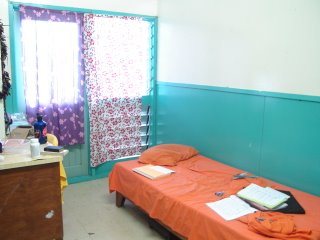
Yesterday was pretty much a continuation of lots and lots of rain. I’m beginning to miss the sun. Apparently last semester there were three solid weeks at the beginning when you never saw the sun at all because it was raining non-stop. No wonder there were so many problems…
To make up for the fact that the rain pretty much kept us in our rooms my roommate and I have begin reading Harry Potter out loud to each other. I’ve never read the books and even now that I am I don’t really see what has caused all the hype. I’m actually quite critical of them and think Harry Potter is a spoiled little brat. I much prefer Artimus Fowl. Reading them has been something to do however when its raining outside and there is no one else around. I don’t remember if I mentioned this or not but the rest of our housemates were moved to other houses last week due to “continued breaking of the rules.” Apparently there were a lot of drunken parties when we weren’t around on weekend, plus there were other issues with rule breakage. I do miss them. All three were from Fiji and it was nice to come back from our travels and know that they would be chilling in the commons watching TV or movies. Now that they are gone our house feels so empty. But back to reading Harry Potter. We sit on the bed, make tea or milo, and eat biscuits while we take turns reading chapters. We’ve about a third of the way through the book.
Last night after reading a few chapters I went back to my room to finish up a few assignments. I was sitting at my desk when I heard a rather loud noise. “Those stupid dogs I thought…boy are they loud tonight.” Next thing I know Kalia was in my room: “Did you just see that cow run by your window?” Yeah I felt just a tad bit stupid. I mean I knew that was a cow noise. I don’t know why I thought it was the dogs. But yep, right outside our door was a huge cowing mooing and groaning and making all sorts of loud noises…at 11:30pm! We debated whether or not to call someone when we saw flashlights approaching in the distance. The security guards tried to move the cow but were successful only in emitting more cow-like noises from the animal. Kalia and I were doubled over in laughter in our house. The whole situation was just so bizarre…especially as it was happening in the rain. I think the security guards heard us because they promptly began laughing at us. I guess that’s the way things go here.
Tomorrow morning, at 2:30am we leave for Fiji. We’ll be gone for a week I believe, but I’m somewhat confused as to the actual time we will spend in Fiji as flying there involves crossing the international date line. We leave Saturday and arrive one hour later on Sunday. I might actually have internet access there since its supposedly more developed but I cant promise anything. Immediately after I finish here I’ll be going to class where each of us will be giving a five-minute presentation on some aspect of Fiji. I’m doing politics and the coup. I’m still trying to figure out how I’ll squeeze that into five minutes as there is quite a bit surrounding that issue. A lot of it has to do with racial tensions between Native Fijians and Indo-Fijians who were moved to Fiji as part of the British colonization of the island to work on the plantations. The other big issue, considered by the Fijians I spoke with to be the biggest issue, involves the land. 80% of the land is currently communal land, with leases that used to last 99 years. As a result of the tension leases have been changed to 30 years, with the result that when many of the Indo-Fijians (who are the ones leasing the land since they cannot own it as non-natives) leases expire the native Fijians are refusing to renew them. Both the Indo-Fijians and the natives recognize this as a problem, at least from an economic standpoint. The Indo-Fijians are the ones who have been developing the land for the past hundred years. As the natives try to move back in, they are finding that they do not know how to get the same amount of yield from the land- whether that is from a lack of experience or a different work ethic depends on who you speak to. But that’s a basic background of the issue. And now off to class.
Wednesday, October 25, 2006
Culture
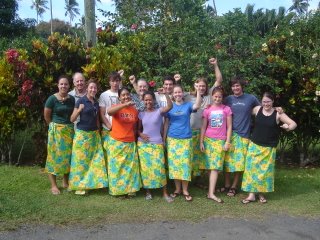
What is culture? How do you define it? Our discussion today focused on changes within the Samoan culture, but reading through the articles I couldn’t help but wonder. What is it that makes one people different from another? Is it even possible to put your finger on the differences? Or can you only see the outward manifestations? How do you map the changes in a culture? I’ve spoken so much about American culture and Western culture and Samoan culture and Catholic culture. But what do those really mean? Culture deals with people- and people are so individual, how do you group them all into one. These are questions that are so hard for me to answer right now. It’s easier to just absorb and do then it is to contemplate and try and understand sometimes.
Speaking of people, I’ve been asked about the other members of my group. As I may or may not have mentioned earlier there are currently eleven of us in the program. They come from around the country and everyone is from a different school. I’m the only economics major. Most of the others are sociology or anthropology majors although there is a linguist and maybe history major as well. You’d think I’d know better but we’ve all been taking the exact same classes for the past two months. The only thing that will be different is our research, but even that will sometimes be hard to tie directly back to what they are studying back home. The topics are also quite varied: effects of Westernization on the language, remittances, waste management, the church, discipline, views on death, composting toilets, small village stores, land tenure, alcohol/clubs, and of course alternative energy. The reasons for coming are also quite varied. Some are here because they have always been interested in Samoan culture or because it provides a really great place for them to do original research in their field. Others are here most because it just seemed like a cool place to go and it fit in with their school schedules. There’s even a guy who came because his ancestors were missionaries in the Pacific. Overall I think we have a really varied and well-rounded group. According to our Academic Director we are also one of the better groups she’s ever had. We’ve told her she should consider retiring after us because we will be impossible to follow.
Tuesday, October 24, 2006
Tourism
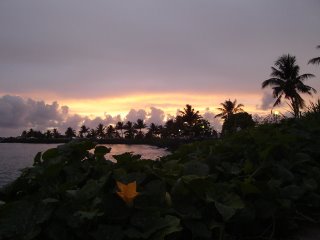
Today our discussion focused on tourism. We had to read two articles by Hawaiian authors who were quite passionately against tourism. I don’t know that I would agree with everything they said, but having been to Hawaii and seen Waikiki I can’t help but sympathize with some of their points. Over six million people swarm the Hawaiian Islands every year, far in excess of the total population of the islands. They create such a drain on resources and have had quite a devastating effect on the cultural. I know that I personally had not thought much of the cultural heritage of Hawaiians before this semester.
The discussion of Hawaiian tourism led into a discussion on Samoan tourism. Samoan tourism is much smaller. There were slightly over 100,000 visitors last year, with 40% of them being returning Samoans. Samoa is also one of the few Pacific Islands nations with an almost 100% locally owned and operated tourism industry. I personally think its better that way. If control of the industry remains in the hands of locals it will develop at a sustainable pace and not come into such intense conflict with local culture.
I really liked staying in the tourist hotels in Savaii, especially the beach fales. There was no hot water. We slept on mattresses on the floor. There were no real walls, no fans, no TV, and only communal bathrooms. But there was a sense of community. We met the family who owned the fales. We ate dinner as a group with the other tourists. It was a very different environment and one which I feel a big foreign-owned hotel would not be able to duplicate.
Monday, October 23, 2006
American Samoa
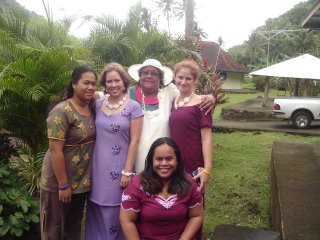
American Samoa. A much smaller, more mountainous group of islands that is now a US Territory. Back in the day its main asset was the deep and well protected harbor of Tutuila. We spent four short days there, and it is still a challenge to decide what to say about it.
I’ll start with our activities there. We flew out from Upolu at 7:30 on Thursday morning on a little prop plane. My perception of things must be changing because it was actually comfort to know that we were going on the “big” plane as opposed to the 15-passanger plane that we used to fly across the ocean the last time. After breakfast and a tour of Pago Pago we drove to American Samoa Community College, the institution that would be hosting us for the weekend. We met our host students and then had a chance to attend part of their YANA (You Are Not Alone) 3rd year anniversary celebration. YANA is an organization that started after three students committed suicide in one year. More on that later. After lunch we had an art class. I must admit that after sitting in lectures for hours on end painting cloth and making siapo bookmarks was a welcome relief. We spent the evenings with our host families. Friday morning we watched a film on a man who tries to bridge the gap between being a Samoan and an American. The man who produced the film was actually our host so we had a discussion with him afterwards which was very enlightening. Our next lecture was by Sia Figiel, one of the foremost Pacific authors. I think it’s always a great opportunity to be able to meet with authors, especially when they are as entertaining as Sia was. Saturday the entire group, SIT students and hosts, hiked up to the Mt. Alava and then down the other side to the ocean. Let me just say now the view from the top is amazing- even though it was cloudy and rainy. It’s, I believe, the highest point on the island and looking down you can see the wharf and main town areas. It was incredible. The hike was a lot of fun as well, especially the one on the way down where we had to use ladders and the ground was slippery and muddy from the rain. We went in two groups. The first group made it to the top and down in under four hours. We then sat and waited another three hours for the second group to emerge from the mountain literally covered in mud. It was quite a sight to behold. I wish I had more time to describe the hilarity and awesomeness of the hike, but I think that’s one story you’ll just have to ask me about when I get home. Sunday was pretty cut and dried. We went to church, had to’ona’i, did a little shopping, and then headed home. I was exhausted by the time I got back and couldn’t wait to crawl into bed.
Now to the fun part…trying to describe American Samoa. As I mentioned earlier it’s much more mountainous than Western Samoa. It’s also much smaller and the beaches aren’t quite as nice. So much for the description of the land itself. Relatively easy compared to the rest.
Aside from the geography, American Samoa is also very different in other aspects of its physical appearance. For one, it is more developed due to all the aid that comes from the US government. There are more cars, more buildings, a very smelly tuna cannery, a bigger wharf, more American restaurants, nice houses. However, with all of this also comes more junk and more outward appearances of poverty. It’s easy to forget that Samoa is poor because it doesn’t have the same look that is so often associated with poverty in rural America. That is not the case in American Samoa. Another thing that really struck me was all the billboards. They weren’t tall and they didn’t scream out advertisements for everything you could imagine. They were at eye level and had messages about drugs, smoking, teenage pregnancy, and early childhood immunization. Another difference in physical appearances was that of the Samoans themselves. One of my sisters had asked me in an email if Samoans were rather large. My response was not particularly. I mean they aren’t. Most of the younger guys here are actually quite ripped. They might have a little bigger bones and be a little taller but I wouldn’t call the majority of the younger people here overweight by any means. It’s becoming a problem, but I didn’t really see a major difference with the US. That is not the case in American Samoa. There, the Samoans were big. Very big. Why? I’m not quite sure. Maybe its all the processed food, maybe its that they don’t work on the plantations as much as they do here. I don’t know the reason. All I know is what I saw.
Culturally and socially there were also some differences, but this is where I begin to have problems. Some things were the same- the respect, the openness with which my host family received me, the extreme hospitality and generosity, the closeness of family ties, the importance of religion (at least in my family). Those things were the same. Others were different. My first night there I had a long talk with the girl who was hosting me about suicide, and family problems, and life choices that many young people are facing. It was a very heavy conversation and I couldn’t help but think that the issues being faced there today are very similar to those being faced by many inner-city youth today in America. It was not easy and I think that is one reason I have having such a hard time sorting through this in my head. I know some of those issues are being faced here, but to this extent? How much an influence has Westernization had on this culture? How much of it has been good and how much has been negative? How do you solve some of the problems that have been created?
Don’t get me wrong. My experience was amazing. My family did everything they could to show me the differences between the way things used to be and the way they are now. The first two nights I showered outside in the middle of the school yard and ate outside with the parents sitting on the ground. The last two days we used the indoor bathroom and ate at the kitchen table. We watched football and I was actually allowed to help cook- things that never happened in the village in Western Samoa. If I could, I would have stayed another week. I think I could safely say that it has been my favorite home stay to date.
And now I think I’ve rambled enough so I will end this post. I’ll share more later this week. J
Wednesday, October 18, 2006
Impossible to miss
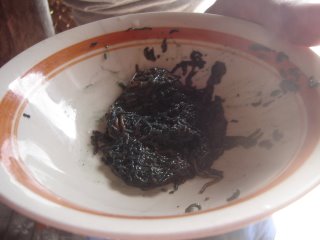
Last night as I was talking with some of my fellow SIT students I realized that I had forgotten to tell you about a very important part of our Savaii trip. At 4:30am on Thursday morning we woke up and walked about ½ a mile down the beach. Out in the water we saw what looked like a bunch of big stones. As we approached them they took on human form. We were in the right place! For the next hour we used pieces of mosquito netting strung on a stick to scoop black and brown moving strands of angel hair spaghetti into a big red plastic bucket. Once the sun came up the spaghetti strands began to disintegrate on contact and it was time for us to return back to the fales- but not before we took turns tasting the squiggly things we’d just caught. We took our catch to the kitchen and asked them to prepare it for us for breakfast. Cooked they were a darker green. They still retained some of their salt water taste, but were quite good on toast. For dinner again we ate more, this time prepare with eggs and onions. I liked the dinner version better.
And now you ask- what exactly were you eating? A Samoan delicacy. It is catchable only one night out of the year in the hours right before the sunrise. There are only a few locations where it can be found and people come from around the islands to catch and eat it. The small handful that we caught would probably make WS$30 in the market. It’s called Palolo. What is that? Do you really want to know? It’s the reproductive organs of a certain kind of coral worm. See! I warned you! It’s really not that bad and it was one adventure I was certainly not going to miss. When else would I get another chance to try it?
Tuesday, October 17, 2006
Academics
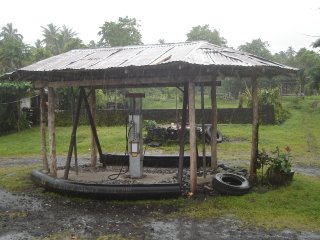
I almost didn't update today. After the excitement of last week not very much happened in the past 24 hours. That and I have a presentation tomorrow so that's kept my pretty busy. So, instead of actually trying to come up with something creative or interesting I decided to copy and paste from an email I just sent a friend from college. Yeah I know- boring but hey...its better than nothing. :)
We had our language exam today. It's a relief to have that out of the way. I've enjoyed learning another language-dont get me wrong but at times it also feels so pointless since so many people speak English. It makes it so much more difficult to learn it on the street. Being done with language means that I only have two classes left. One is a seminar on Pacific culture, and the other is my research project. The seminar class has actually proven to be quite interesting. All of our lecturers have been very knowledgeable in their fields, and we've covered a variety of topics. In the beginning we were learning things about the Samoan way of life, the rule of law, the role of the church, economics, etc. This month we've moved into the traveling part and so it's become more of a comparison of cultures. The lectures in Savaii were mostly geological in nature, and in Fiji I think we'll be looking at the effects of tourism. It's been interesting, but I must admit I wish there wasn't going to be a test at the end. As for my research project- I'm doing that on renewable energy development in Samoa, more specifically the use of solar. It's coming down to the point where I need to actually define my topic and draw up an outline. As of right now I'm thinking of looking first at the philosophy behind electric development because it's really not based on economics. I read through one of the proposals and under the financial analysis it basically said yeah we aren't doing one because it would be pointless. I think it'll also be interesting to research because there is next to nothing in written form about the subject, which means that whatever I do will be based on interviews. For the second part I'll hopefully be working with the electric company to actually look at the feasibility of using solar panels to power one of the few places in the country that is currently not connected to the grid. This would be my opportunity to actually run the numbers and do some economics, plus it would actually benefit the company. In return I think they might be taking me out to visit one of the smaller islands. So that's pretty much where I am now in terms of academics.
Monday, October 16, 2006
Bark cloth
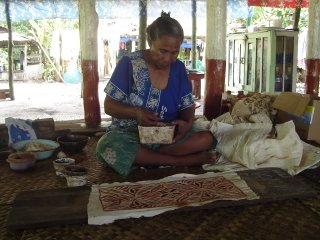
After using the computer at the internet café in Apia earlier today the snail-like speed of the internet at USP is really frustrating me. I’m finding it impossible to even send an email. As my research project heats up I’ll probably be spending more time there doing using the computers/internet. Before that happens though we have two more trips planned. A short four day visit to American Samoa and a week long visit to Fiji. I’m feeling a little spoiled right now.
I realized on the way into town today that I’d completely neglected to talk about one of the activities that occupied our time in Savaii. On Wednesday morning we made Siapo or bark cloth. Talk about labor intensive! The technique and the tree used both came from China. I don’t remember the name, but it’s a very thin tree, maybe an inch in diameter with few branches. The bark is stripped from the tree, which is easier than it sounds. A small slit is cut at one end and then the bark just peels right off the tree. That’s the easy part. Next, the inner bark is separated from the outer bark. That part is harder than it looks. What you’re left with is a thin, sticky, but long piece of white inner bark. The next step in the process is to remove the glue that holds the bark fibers together. This is done by scraping the bark with a seashell over and over and over again. When the stickiness is gone the pounding commences. What began as two inches wide will become a foot wide due to the repeated pounding of the bark over a piece of hard wood. Once the bark is pounded it is stretched out in the sun to dry without losing its shape. The rest of the process is fairly easy in comparison. Dry pieces are pained and glued together using a starchy paste made from cassava (a root). The paint is made from the die of another tree’s bark and is heightened by the use of red clay. Traditionally the back cloth was used for ceremonial purposes- wedding garments and dance costumes. Today you can buy small pieces in the market to bring home as souvenirs. I got to make my own small piece to bring back. While I didn’t make mine from start to finish I was able to try out the entire process. Trust me, its very labor intensive and time consuming. Hopefully I’ll be able to show you what I made, but as of right now there has been a slight mix up and we aren’t 100% sure of where exactly our siapo is at the moment.
Back from Savaii
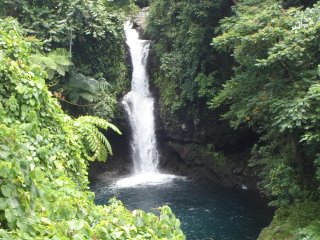
I’m back from Savaii, and what a week it was! It’ll probably go down as one of my favorites of the entire program. It felt almost like we were on vacation except for the few assignments we had due while we were there. We toured around the island with a 75-year geologist from Australia. He reminded me a little bit of my grandfather, and I know that if he had been there they would have had some pretty intense rock discussions. I think Warren, our guide, was a little disappointed that none of us knew anything about rocks.
We visited the largest ancient known Polynesian rock mound. They have some idea of when it was build, but no clue as to why. Perhaps human sacrifice? Maybe for pigeon hunting? They just don’t know. A short hike away was a 45ftish tall waterfall with a beautiful clear water hole that was used as a swimming hole. Jumping through a waterfall is a lot of fun! We also visited some blowholes, did a cliff walk, hiked a mile through lava fields, and saw some other random touristy things.
Thursday we moved from the hotel where we’d been staying to some fales on the northern side of the island. Talk about amazing! We were right on a beautiful sandy beach, but without the swarms of tourists that we see so often in the states. It took thirty seconds to go from my fale to the water. Needless to say I spent quite a bit of my spare time snorkeling or just relaxing under a palm tree.
Saturday was possibly one of my favorite days. In the morning a small group of us hiked up to the dwarves cave. It’s a huge lava tube of undetermined length, but legend has it that a group of small people once inhabited it. A man found them while hunting and in return for keeping their location a secret granted him all his wished and made him a wealthy man. Unfortunately he did not keep his secret forever and several years later shared the location. When others from his village went to investigated they found no one there, and when they returned to the village all the man’s possessions have disappeared. Perhaps the magical dwarves are still down there, far far underground where no one else has explored. Going through this cave was something else! There was a very small, maybe 4 ft in diameter opening, but then once you got inside it was easily 9 ft high and fairly wide. We had three lights between the five of us and our guide so you can imagine how dark it was. We had no idea where we were going. At one point the path dropped into a pool of water and our guide told us we would be going down and then swimming across to get to the other side. We looked at each other and just went ummm…. It was unreal. You would never get to do something like that in the states. There would be all sorts of warnings and handrails and protections in place. But it was so much fun! We spent a few hours with our guide and afterwards he climbed a coconut tree and got us something to drink. The craziest part is that at the very end after we’d been invited to come back and spend a few days with his family we found out that he was our language teacher’s brother.
Later that evening, right before sunset I managed to get two of the people who hadn’t come on the hike to go kayaking in the ocean with me. Everyone else was too tired. Me? I was so pumped. We were out in the water for about an hour and let me just say that riding those waves was a blast! I would love to go again! I’ll admit I took a few tumbles and lost my kayak at one point but catching some of those bigger waves was such an adrenaline rush!
Sunday we came back to Alafua. This time the hour long ferry ride was full of people coming back for work and school on Monday. Samoans are generally laid back until it comes to transportation. I’ve never seen such a mad dash for a small opening. As several others mentioned- its worse than the subways of NYC if you can believe that. I’ll have to leave the full description of the ferry for later however as I have class very soon.
Friday, October 06, 2006
Making my day
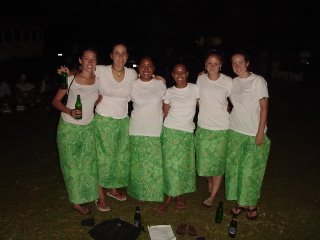
I just got back from the hospital and visiting Kati. It’s pretty much official. She’ll be leaving to go home next week. It’s hard to believe. A small cut and now she’s looking at having to get skin grafts to repair some of the damage caused by the bursting blisters. The culture came back today as a staph infection. Apparently 90% of Samoans are carriers of the bacteria which explains why it was so puzzling to us. I’m planning to go into Apia tomorrow to do some gift shopping for Kati since she won’t be able to now.
I think I’ve mentioned the incredibly friendliness of Samoans, but I have two more examples. After leaving the hospital I began walking back down towards Apia. I figured that if I had to wait for the bus I might as well get some exercise at the same time. Several minutes later a taxi pulled up beside me and the woman in the passenger seat asked me where I was headed. I replied Apia and she offered to let me ride with them. Turns out the lady works at Med Cen (the private hospital where Kati is staying) and she and her husband were on their way into town to do laundry. She’d been working last night and I guess recognized me.
The second example involves my research. Last fall one of the boys on the program had worked with someone at SPREP on a project involving climate change. Jackie recommended that I contact him to see if he couple at least help point me in the right direction. Despite the fact that alternative energy is not his field at all he has done so much to help me. He has provided me with names and contact information, and invited me to come by his office anytime. Since it’s only a five minute walk from the hospital I scheduled a meeting for today. We talked for about an hour and he gave me all sorts of tips and pointers, offered to dig up some reports for me that I would probably not have access to otherwise, gave me some more names, showed me around the office, and then drove me by the store to pick up some of the most delicious apples I’ve ever had (they were for Kati but I bought one for myself as well), and then to the hospital. He went out of his way so much. I was amazed. He has to be busy, but he was so willing to help a student. I think back in America it would be incredibly hard to get the kind of access that is, I fear, going to become second nature to me before I leave.
Tonight is the talent show. Wish us luck! We have to perform our dance again.
Laziness
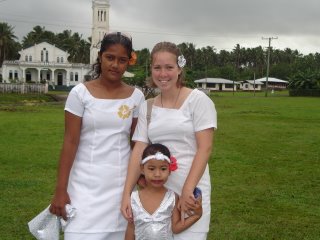
I have no real excuse for not updating yesterday except for that I was feeling rather lazy. I spent a lot of time in the computer lab yesterday because we had our first paper due today. Yeah no big deal, but most people in the group seemed to be stressing a little bit too much about it. I did mine on solar power in Samoa and some of the challenges that face small island nations. For example, even though it is good in theory the technical expertise to service projects is not always available. Also, even though villagers want the services provided they do not always provide the necessary maintenance to ensure long-term project success. I don’t think this is something that is completely unique to Pacific Island countries, it just so happens that the resources and funds to designate someone else to care for the project are not available as they are in other countries. The second part of my paper focused very briefly on the solar project on the island of Apolima.
I spent last night at the hospital with Kati. We’ve been taking turns sleeping there so she isn’t there alone and last night I volunteered since my paper was almost finished. It’s so bizarre. The doctor is not completely sure what it is- possible an infection right below her skin. It had looked so much better when I went to visit her two days ago, but last night the redness was back. There was talk last night of med-evacing her to the United States because it might be a prolonged recovery. That way she would at least be with her family. Jackie is obviously disturbed by the suggestion. This is the first time in ten years anything like this has ever happened. I think it’s confusing a lot of people right now. I hope she gets better. We all miss her.
Also, another heads up. Saturday morning we leave for Lotofaga for White Sunday. We come back Sunday afternoon but turn around Monday and go to Savaii for a week. Once again, internet might be non-existent so don’t panic if you don’t hear from me for a little while. I will return!
Thursday, October 05, 2006
Education in Samoa
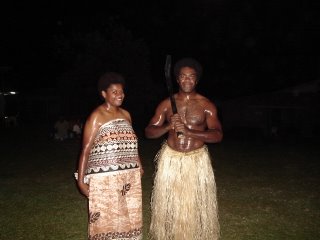
Today was very long. I spent last night with one of the Samoan students at her sister’s house so we had to wake up at 6am to catch the bus to Apia and then another bus from Apia to Alafua. Instead of meeting at 8am as on most mornings we were meeting at 7:30 because we were going to visit several schools and wanted to see assembly for the first one.
Our first school was Don Bosco, an all-boys vocational school located about a mile away from the USP campus. It is run by the Salasian Priests and has a current enrollment of around 250. The boys range in age from 16-21. I’ll be honest. Visiting did a lot to restore my faith in religion here in Samoa. I’ve spent the last couple weeks seeing a lot of the financial corruption of religion here and it had left me wondering- where are the Catholic priests? What happened to the missionary spirit that so inspired me when I read the stories of the Jesuits who came to North America? Do people actually believe what they are preaching here? What I saw today convinced me that yes, the Catholic Church is still very much alive here and interested in helping the people of Samoa. I’m sure you know the story of Don Bosco. He founded an oratory to help trouble boys; to give them something to do and take them off the streets. This school fulfills much of the same purpose. In the 1980’s the Catholic Church did a survey in the country to see what needs were not being met and they realized that large numbers of boys were dropping out of secondary school which was really limiting their ability to get a job. In 1989 (?) Don Bosco Vocational school was opened to train young men and give them the technical skills necessary to obtain jobs. I finally saw what I wanted to see here in religion. A place where ability to pay is not an issue. Term tuition is WS$130 or approximately US$50, but even that is too much of a financial burden for some students. Rather than turn the away the boys work for a few hours on Saturdays at the school to earn their tuition. As a side note, all of the other religious groups in Samoa have followed the Catholic’s lead and now have technical schools of their own. We spent about an hour and a half at the school. The first half was spent observing assembly. They sang for us which was great because they won the Teuila Festival competition so many years in a row they have been dis-invited. In other words, they are pretty darn good. Father also gave a speech in which he thanked us for coming, especially since we brought so many girls. I don’t think everyone else in the group found it as amusing as I did. After the assembly we toured the workshops- a mechanic shop, work working, and metal.
After Don Bosco we went back towards Apia to visit a special needs school. They mainly deal with deaf students, but there are also some other physically handicapped students. Once again, most of the money for the school comes from private or overseas sponsorship. Another interesting thing to note is that there is no Samoan sign language so they use Australia’s. That means that in order to translate they must first go from Samoan to English to sign. Very complicated. Also, sign language was not introduced into the country until the 1980’s. Most people still communicate using their own personal language. Jackie also mentioned that there seems to be a disproportionate number of deaf people in Samoa. Is there a reason for that?
Our final visit of the morning was to NUS- National University of Samoa where we had a lecture on education in Samoa. I wish I hadn’t been so tired because I might have gotten more out of it. I was just wishing that the next door neighbor’s baby had cried all night. :-P
The afternoon was spent doing research. I went back by EPC and talked to the head engineer. I have a very good chance of being able to go to the island of Apolima in November. I really hope it works out because it’s a very hard island to access. I think I also have a much better idea as to what my research will cover- which is always a good thing. My meeting at EPC finished early so I had about an hour to kill before the research center at SPREP opened. I knew it was straight up the road but wasn’t sure how far away it was so I decided to start walking and catch the first Vailima bus that I saw. Many busses passed by, but not a single one said Vailima. I walked for just under an hour and still no bus. By that time though it didn’t matter because I was where I wanted to be. My best guess is that I walked about four miles. Nice little walk. On the way back I caught the bus, but not before stopping by the hospital to say hi to Kate (whose foot is looking ever so much better) and leaving my nalgene at a corner store (that makes me very sad.)
And now, off to do some more research.
In search of the perfect cone
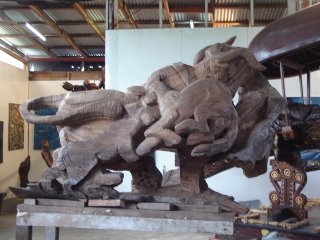
Last Sunday after another ice cream cone from McDonald’s I decided to make it my mission to find the best ice cream in Apia. I tried two places today- a little road side stand, and Lily’s Cakes and Cones. I think Lily’s might be my favorite so far, and after being disappointed in the road side stand I think I might very well stick with Lily’s and this grocery store stand that also has some pretty decent ice cream. In other words, my quest didn’t last too long.
Classes today were pretty short. We finished up our presentations on the village, did a short language activity, and then visited BEN’s School of Art. BEN stands for Beautiful Expressions of Nature and is one of the few art schools in the country. Traditional art forms such as singing and dancing are very much alive; but some of the other forms such as sculpture and painting are almost non-existent. The owner of the school has made it his mission in live to give visual art a more prominent place in Samoan culture. He’s working almost single-handedly which I found incredible. Since the government of Samoa does not really have funds set aside for projects such as his he depends on oversees grants and small projects that he and his students make for churches. One of his carvings was displayed at the Atlanta Olympics and is now in Las Vegas. Another is part of a just completed Chinese sculpture garden. To me the most amazing part was his workshop. His current goal is to turn part of his workshop into a museum with the hopes that it will become the first national museum of Samoa. In the middle of the workshop is a huge hollowed out tree trunk, probably 10x15 feet on which are the beginnings of a new carving. All around are other smaller logs which will soon become sculptures themselves. The completed sculptures which fill up the first half of the room are equally impressive. How do you take a cylinder and turn it into a three-dimensional picture? I think that is something that will always amaze me.
As I was walking around Apia this afternoon in the heat I realized that I’d forgotten another village story and this one I just have to share with you. There are lots of stray dogs or maybe just dogs in general in Apia. It’s one of the few complaints tourists make. One of the first days we were here we were told that they have a tendency to walk along beside you and then all of a sudden they’ll just turn and bite you. One afternoon in the village I was walking with Mirna, RaEsa, and RaEsa’s Samoan mom. We were going down to the little shop to buy something- I don’t remember what exactly. As we were walking along the side of the road we heard a car coming so we moved over into the grass and watched it pass. I turned back around to see this pretty ugly grey dog standing next to me. It looked almost like a greyhound but I knew it wasn’t. The first thing that came to my mind was the warning about dogs that like to sneak up on people. I searched my memory for the correct word to yell at the dog but before I had a chance to open my mouth that “mangy mutt” to steal my grandfather’s term bit me! I was so mad. I couldn’t believe it! That stupid dog actually bit me! On my leg! All I wanted to do was punch him in the nose but I think he knew it was coming and took off running across the yard. I mean serious! What had I ever done to it! Mira and Esa of course were almost crying from laughing so hard. I was so angry. That didn’t help. They thought that seeing me ready to beat that darn dog was the best part. Thinking about it I’m still angry and I can guarantee you that if that dog ever comes near me again he wont be biting any more innocent pass-bys. The End. (Side note- he didn’t draw blood and they don’t have rabies. It was more just a lot of hurt pride and a small bruise…but still! The nerve!)
Monday, October 02, 2006
Samoan humor
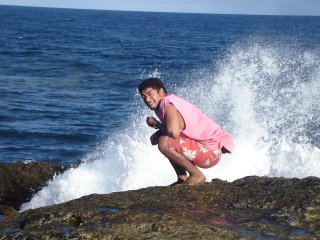
In Samoa you laugh at everything; even things that aren’t funny like a little kid getting beaten. However you are also allowed to laugh at things that would be considered funny in American/Western humor. Last night before dinner we all had to share one funny moment and one moment that really stood out from our trip. Going around the table I realized that I had neglected to mention some of the funny stories from the village so I’ll try to share a couple of those now.
Tuesday, after we made the umu, we went back to Jackie’s house to play a language game. Let me first describe the layout of the “compound” for lack of a better word. The school building/Jackie’s house is in a circle with four other houses and a store. A little further back is a fifth house, the Samoan kitchen where the umu was made, the chicken coop, and several other storage type buildings. This little area is where most of Jackie’s family lives. But back to the game. The game that day was a scavenger hunt with the clues given in Samoan. We were told that it was a race and that there was a nice prize to be given to the winning team. My team was composed of three people: Mira, Rachel, and myself. We were given the first clue which said something about the “falemoa” or chicken house. We looked at each other and ran out the door not stopping to put on our shoes. This turned out to be somewhat of a mistake since the muddy ground was strewn with rocks and coral. We quickly picked our way across the courtyard until we came to the house that was removed from the rest and called out to the group sitting inside “falemoa?” They looked at us and pointed to the right. Off we went. We must have made a funny site holding our language books and lifting our knees high in reaction to the sharp path. I reached the coop first and grabbed the pink paper which said something about the book “Mary Mary.” “That’s on the bookshelf,” Rasela called so we turned to go back. As we quickly started picking our way back across the yard I realized that something didn’t feel right. I looked down to see my lavalava undone in front and threatening to fall off completely. All I could think of at this critical moment was Jackie telling us to “Pick it up and twirl it around” if it were ever to fall off in public. Trust me if it had I very well might have.
Another funny story that wasn’t quite so funny at the time happened one evening after dinner. Although the family I stayed with had electricity the bathroom (which as I mentioned earlier was slightly removed from the house) did not have a light in it. Not really that big of a deal right? Usually the light from the room from the upstairs room filtering in through the slot above the door was enough to allow you to see all that was necessary. Since dinner was normally eaten around 7pm the sun had already gone down and darkness was only broken by a few street lights and the lights from the few nearby houses. We were sitting in the Samoan fale when suddenly there came a screaming from somewhere across the yard. I knew at once that it was the four-year old but I had no idea where she could possible be. Had she fallen down and gotten stuck somewhere? Vaiula and I ran across the yard to try to locate her. It was then that we realized that she was in the bathroom- stuck. Let me say another word about the bathroom. It was build out of wood with a metal roof and concrete floor, and was just big enough to hold a toilet and a person. It could be closed from the inside by a sliding latch and the outside by a wooden bar that slid across to hold the door closed when it was not in use. One of the first things I’d noticed about the sliding latch (similar to the ones in bathroom stalls across America) was that the metal part which stuck out a bit had a tendency to fall out and get lost on the floor. This meant that if you wanted to leave the bathroom you had to search on the ground for it. Easy enough during the day but at night? You’d better hope that you could find it by the light reflecting off of it. Once we knew where the source of the sound was we knew what had happened. She’d lost the pull and couldn’t get out. Her grandfather came running across the yard and proceeded to try to yank the door from its hinges. No luck. Whoever had attached it had done a great job. At this point I was torn between feeling bad for the poor little girl and laughing hysterically like the rest of the family. I mean- she was stuck in the bathroom! But then again- she was stuck in the bathroom because the latch didn’t work but why replace something when it can still do the job? Finally, the grandfather picked up the ten year old and stuck him through the twelve inch gap next to the ceiling. For a ten year old boy it was fairly simple to find the missing piece, insert it in the correct place (also rather tricky even in the daytime), and open the door to free the still terrified little girl.
That’s all for now folks! Today was rather uneventful. After starting class at 10am (yay for the free morning) we had to give presentations on some aspect of the village that we’d been assigned before we left. After lunch we divvied up the gifts from the village. Some people went into Apia while I set up a few research meetings for later in the week and then headed back for a pretty fantastic two hour nap.
Sunday, October 01, 2006
Ten days in Lotofaga
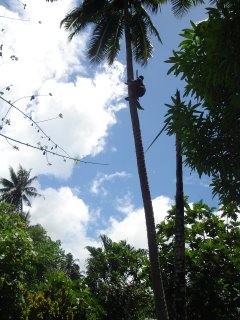
I’m BACCKKKKKK!!!!!!!!!!!!!!!!!! Ten days in the village and I’m still alive and kicking. Maybe it wasn’t that bad after all. There were some times when it was a little hairy, but overall I must say it was a very good experience and I’m glad that I did it.
I stayed with a family of six. My host mother, Sipili, is a Grade 1 teacher and the assistant principle of the local primary school. Her husband Tuaitau is a planter. They have five children- four boys and one girl. The oldest boy, P.S.A, lives at home with his wife Conzuela and their two children Laisene (who is almost 4) and Edweena (who is three months.) Sipili’s two youngest children, a fifteen year old girl named Talia and her ten year old brother Viula also live at home. The other two boys work and live in Apia and I never met them.
They live in a rather nice palagi house. It’s two stories with a connected bathroom and shower. I was one of the lucky ones who had an actual bathroom to shower so I didn’t have to use the bucket by the road. They also had a fale Samoa which is where the parents slept and spent most of their time during the day since it’s cool and gets a nice breeze. The other two buildings on their piece of land were the kitchen and the Samoan kitchen which is where the umu is built.
About half of my time was spent in class at Jackie’s house, which was nice because I think I might have gone crazy otherwise. Don’t get me wrong. Some of the members of my family were very nice. I loved my sister-in-law and her two kids. Without Zuela I probably would have gone crazy. She’s twenty-six, very pretty, and also I think a bit lonely. She comes from another village and moved here to live with her husband’s family. Her own village is a fifteen minute drive or so, and her family owns some beach fales which are popular with the tourists. I could be wrong in this, but it seems like most of the work around a house is done by the in-laws. Zuela did all of the cooking and most of the housework in my family. At one point I asked Talia if she liked her sister-in-law and her response was “oh yes, because she does all my chores for me. I just go to school and play volleyball. Zuela does all the rest.” The same was true for the family across the street where Mira stayed. Most of the plantation work was done by the son-in-law, not the sons who still lived at home and spent most of their time laying around and playing volleyball.
In general life is very relaxed. Unless a person has a paying job they don’t really do a whole of anything during the day other than getting and preparing food, and relaxing. Don’t get me wrong- it’s not that easy when it means picking or fishing or killing every meal you eat, but there is still an awful lot of sleep and down-time. It was quite strange, especially for us girls who then had very little to do since most of the work, including the cooking, is done by the men. It was a little different in my family since Zuela cooked most of the meals, but even then it was nothing like what we were expecting.
Going to the beach isn’t that popular either. It’s a ten minute walk to a beautiful sandy beach on a reef, but most adults never go unless they are fishing. I took my snorkeling set out several times. It’s so easy to get lost in the underwater world. The little boys also loved my set so it was hard to go for very long. They monitored my time usage pretty closely and made sure to tell me when my time was up.
It would be hard for me to go through a day-by-day play of what I did so I’m going to copy and paste bits and pieces from my own personal journal, and use that to build on for the rest.
9/21/06
“I find that part of me begins to agree with Kalia. I’m only five years older than Talia. She does not have to be my slave.” One of the hardest things for most of us to get used to was the almost stifling service. The first thing my host mom did when we got back to the house after the welcome ava ceremony was sit down and tell me that I was her daughter and that we were family. She then proceeded to not allow me to do anything on my own. We all wanted to fit in and be part of the family but it was not something we were really allowed to do. Or at least some of us weren’t. I ate with the parents, was served by my supposed sister, got food no one else got to eat, and was not allowed to really help with anything when Sipili was around. One of the nice things about Zuela is that she would let me cook and eat in the kitchen with her and help her with her chores. I was able to experience some of the actual work that went on. I also just really wanted to eat what everyone else was eating. It’s hard to eat much when you know the little kids are eyeing your food and just wishing that they could have a bite. Looking back the first couple days were very much days of hostility. We went in being told to try as much as possible to become part of the family but looking back that is a rather unrealistic expectation. Once I gave up trying to do that fell into a more comfortable “long-term guest” role I was able to enjoy myself much more. Some people were going to treat me a certain way and I left it at that. Sipili was going to insist on cutting my taro every evening at dinner. There was nothing I could do about that and so getting frustrated was pointless. On the other hand, since they insisted on treating me as a guest I had more freedom to wander around with some of the other students.
9/23/06
“Riding to the plantation today was pretty sweet, but I wish they’d let me ride the horse by myself. It would have been so much more fun! I know- I’m complaining.” As I mentioned earlier my host dad was a planter and they had two plantations. One was right next to the house and the other was a fifteen minute walk. The plantations mainly hold coconut trees and taro, and someone from the family goes almost every day to collect the food for the evening meal. That would be one of the hard parts of life. Many of the families who worked the plantations also had horses to haul back the food. Horses also served as lawn mowers I was told. Families who don’t have horses still cut the grass the old fashioned way- with a machete. Sounds like fun right? Since I’d expressed a desire to ride the horse when I arrived on Thursday they told me that they would let me ride it on Saturday. I felt like such an Indian. We used a rope for a bridle and leaves for a saddle. It was pretty amazing.
9/24/06
“Thoughts on the day- they just drag by so slowly. We don’t do much besides eat and sleep. The heat kills all desire to move around and be active. Wow ok and the wind just changed directions- not the best smell. The pace is so different from the States. I haven’t really figured out what people do here. But more on that later- I’m going to go help my ‘sister’ with an assignment.” The assignment was an English assignment. I helped her with several during the week and they were pretty tough. I don’t know where they get them from but I’m not really sure how they expect them to come up with the answers.
9/25/06
“Last night I had so much hostility. Waking up to find gum all over my clothes- I waws so angry with Talia.” I shared a queen size bed with my Samoan sister and she went to bed with gum in her mouth. I woke up to find my arm in the gum and it all over the back of my shirt. Needless to say I was not so happy, especially since I’m not sure how accidental it was. The evening before she’d wanted to go get pancakes = doughnut holes. We spent two hours waiting for them. Or rather, I spent two hours sitting around and she spent the time flirting with her boyfriend. When she was finally ready to leave it was time for our evening check-in so we went straight to Jackies. Neither of us had eaten dinner and since I hadn’t eaten she couldn’t go home because she would have gotten in trouble. So, while we were in class she sat outside with her boyfriend. We ended up having snacks and stuff so I was fine, but she ended up not eating and I think she was a little upset at me. It was definitely not my fault. I was almost in tears by the time we’d gotten to Jackie’s house. I was hungry, tired, frustrated, and feeling very used by this fifteen year old. Oh that and she didn’t want to give me back my change after I’d paid for the doughnut holes. Jackie assured me that she’d done it before and had probably stolen $100 American from the last SIT girl. I’m glad she told me that because it helped me realize that I didn’t have to be quite so nice. Sunday evening was probably the low point of our trip. Talking to Jackie that night the light bulb went off in my head and things got much better. “I think things will be ok. It was rough for a little while, but I think they might be changing for the better.”
9/26/06
“Watching the sun rise from my bed this morning was so beautiful and so random because it only lasted for a minute or so. Looking past the mosquito net and glass and screen it was the first thing I saw when I opened my eyes. The green and yellow foliage of the tree tops and the dark green of the coconut trees met the pale blue sky, and in that space the white clouds became a swirling mystery of colors. Was it purple? Or a darker blue? Now it was golden. Nor was it the entire sky- just the little piece framed by two tall coconuts and partially hidden by ever-green trees. This was the beauty that has captured the hearts and souls of so many sailors and poets. A breathtaking moment and a glimpse of paradise.”
“Things I learned today/did today:
- learned how to build an umu ( a Samoan oven), from lighting the fire and heating the stones to covering the food with leaves
- scraped taro with part of a tin can to remove the dirt and purplish inner skin
- peeled green bananas with a sharpened sick and got sticky goo all over my hands
- scraped the inside of a coconut. As with everything else it was much harder than it looked
- wrapped the palusami in its many layers of leaves; yes there is a trick to it
- husked a coconut despite the fact that the husk really liked being where it was
- made an eating plate/bowl out of the leaves of a coconut tree
- saw a pig killed and gutted
- realized that big lung is quite delicious when cooked well
- ate some delicious octopus
- watched a deaf man climb a coconut tree with a knife between his teeth
- watched cocoa being made
- learned how to sasa, a dance done sitting. It mainly involves a lot of clapping and knee slapping
- blew the conch for sa. This was one of the highlights for two reasons: it took me about ten minutes to figure out how to place my lips; and because my Samoan mother told me at dinner that Mira and I were the first girls to blow the conch in Lotofaga because it was a boy’s job
Oh and I saw an awesome shooting star last night. I think it might have been my first one ever.” Tuesday was one of the coolest days because spent it in hands on learning.
9/27/06
“When I woke up this morning I helped Zuela make cocoa rice. Tuaitau had already done the cocoa but we still had to husk the coconuts, scrape them, and squeeze the milk from the shavings. It was delicious, but it made me appreciate how hard they have to work for food. When they are happy living at a basically subsistence level there is no need to do much more. You spent the time you need preparing food but after its all over you are free to rest. Tuaitau didn’t leave the Samoan fale for hours. Several of the girls were complaining about not having anything to do- but that’s exactly what they do everyday- nothing. We are just so used to the rat race of everyday life and the mentality that being busy makes you important that we cannot accept that ‘doing nothing’ or ‘malolo’ is a perfectly acceptable way to spend the day.” Wednesday we had no classes so that we could spend another day with our families observing life. It was nice to have another break in the middle of the week when we’d gotten a little more accepted into our families and were actually allowed to help with some things and not relegated completely to the “guest on the side-line” role.
9/28/06
“Today was a very long day in terms of hours and things done. We spent the morning observing and teaching in the Primary School of Lotofaga. Niko, Cheryl, and I had Level 7. We went over food groups with them and then played hangman. Question: what kind of food is a breadfruit? How about taro?
In the afternoon we all went to a beautiful and quite stunning water fall. With all of the rain we’ve had lately it was roaring. The power was quite impressive. The roar, the white mist, the dense green all around. It must have been 70 feet tall. What would it be like to be the first explorer to see that? To hear it and know it was out there somewhere? What would it be like to be hiking through the rainforest? It makes me really want to go to South America.
Later in the afternoon I went to the blowholes with Zuela and PSA. It was somewhat of an ordeal because my mom wasn’t sure if she wanted to let me go. The mothers are convinced part or maybe all of Kati’s sickness is caused by the spirits and they are afraid it is because of her visit yesterday to the blowholes. Since she got hurt on Tuesday though that’s not possible. The whole spirit thing is interesting however. Even Jackie believes it. How do you reconcile that with Catholicism? I don’t think I know enough about their beliefs. Poor Kati though. She seems pretty sick and last night with the healing/Samoan medicine must have been pretty painful. But back to the blowholes- the tide wasn’t right so there was nothing but air. However the lava formation itself was worth the 10 minute walk and 2 tala. I would have regretted it if I hadn’t gone- esp since I was so close. I’m glad I went with PSA because he knew it well and I felt safe following him out. It was also nice because Zuela has never been to that side of it. We even saw a small shark in one of the little coves. The coral was also pretty intense in one part. Other highlights: waiting 10 minutes to get a picture of the wave action behind PSA; going down to check out the underneath water flow; the huge cave; getting a fish and shellfish from the fishermen in the sandy beach on the opposite side.” I don’t know what else to say about this day. We were going all day, but I was able to see some of the natural beauties of the area.
9/29/06
“The fiafia was tonight and despite my fears that it was just another annoyance it was a lot of fun. Time to just relax and let it all hang loose. Some of the mothers were absolutely hilarious and almost dirty dancing if such a thing is possible in Samoa. Others, like my mom were more formal and serious in their dances. Both groups did several numbers. I feel like our dances went very smoothly if I may say so myself. The boys totally stole their show though with their play. The audience went wild with laughter the first time one of the boys said he “wanted some milk.” When it came to the free-style dancing Niko really stole the show.
The bad part about the fiafia was the pulitasi I got as a figt. I didn’t know whether to laugh or cry when I saw it. It was absolutely hideous. Black background with bright big flowers all over it. I don’t know where they got the fabric but I doubt they could have picked an uglier one. Kalia says I’ll laugh about it later and I’m sure I will.” Memo: I’m laughing now. I’m sure you will too when you see the pictures. :-P
“Poor Katie is still pretty bad. Jackie missed the fiafia because she took her to Apia. This morning when we got to school the healer was there working on her. You could tell that Kati was in so much pain from her crying. It did not help however. Jackie seems convinced that it’s the spirits and that she’s not getting better because she doesn’t believe in them or the healer. I’m not so sure about that. I think the problem is more that Kati was not doing anything to help herself. Not only was she not eating, but more seriously she was not drinking much at all. She was getting very dehydrated and that I feel is the main reason that Jackie decided she needed to go to the hospital- to get an IV.” Kati is doing so much better now. It was probably a combination of several things- a sprained ankle, an infected coral cut, and dehydration. She’s going to with us to get pizza tonight so that’s a very good sign. Except for her taped ankle she looks almost as good as new.
Subscribe to:
Posts (Atom)